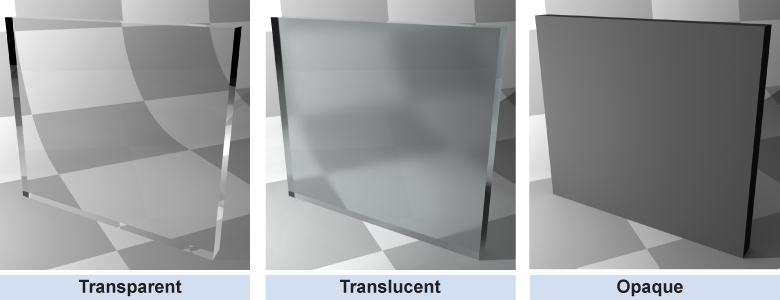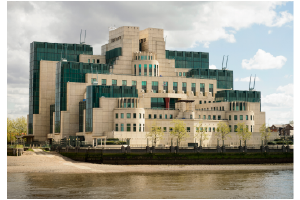|
Window glass is transparent whereas wood is opaque. In the context of physics, a perfectly transparent object allows light rays to pass through with no loss of energy. A perfectly opaque object absorbs 100% of any light energy and completely stops light rays. Transparency and opacity depend on the material of the medium and also on its shape and surface characteristics. Even glass can be opaque when ground up as a powder. 
|

|
Many bathroom windows let in light but you cannot see an image through them. Frosted windows are translucent, which means that light rays pass through but their direction is scattered so the information (images) gets blurred or is completely eliminated. Transparent materials can be made translucent by changing the surface texture. 
|
Many objects may display all three properties—transparency, translucency, and opacity—to various degrees. The diagram at right shows an example. The optical properties depend on the application. Optical glass for eyeglass lenses must be nearly 100% transparent with 0% opacity (although a darkened coating may be applied to the surface to turn them into sunglasses). 
| 
|
A substance that is transparent to visible light may not be transparent to other wavelengths of light. For example, sunglasses may be 50% transparent to visible light yet only be 0.1% transparent to ultraviolet light (99.9% opaque). Earth’s atmosphere is transparent to visible light but partially opaque to infrared light. This results in the “greenhouse effect” in which solar energy arrives as visible light but heat energy cannot escape as infrared light. 
 |
 Have you ever listened to the radio when inside a building with the windows closed and the curtains closed? How can the radio waves reach you? The material of the building might be opaque to visible light, but it is transparent to radio waves. As we will learn later in this chapter, radio waves and visible light are both electromagnetic radiation. Some materials, such as wood or drywall, are transparent to one kind of light while being opaque to other forms of light. This property is very important for building design when you want to prevent outsiders from “seeing” into your building using radio waves or microwaves. Intelligence agencies, companies that do work for them, and embassies all must consider the transparency of materials when designing and constructing a building—such as the headquarters for Britain’s MI6 agency (shown above).
Have you ever listened to the radio when inside a building with the windows closed and the curtains closed? How can the radio waves reach you? The material of the building might be opaque to visible light, but it is transparent to radio waves. As we will learn later in this chapter, radio waves and visible light are both electromagnetic radiation. Some materials, such as wood or drywall, are transparent to one kind of light while being opaque to other forms of light. This property is very important for building design when you want to prevent outsiders from “seeing” into your building using radio waves or microwaves. Intelligence agencies, companies that do work for them, and embassies all must consider the transparency of materials when designing and constructing a building—such as the headquarters for Britain’s MI6 agency (shown above). 
|
Are tinted windows on cars partially translucent or partially opaque?
 |
Tinted windows on cars are partially opaque. Less light is able to pass though, so they are darker. This provides privacy and prevents glare from the Sun.
A translucent windshield would not be helpful, as everything seen through it would be blurred. 
|

